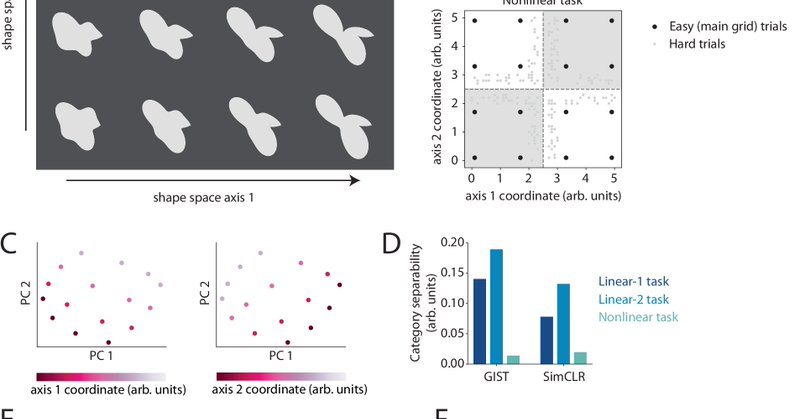
Maggie Henderson
@maggiehende
Followers
390
Following
1K
Media
7
Statuses
87
Assistant Professor at Carnegie Mellon University | human visual cognition, computational modeling, natural image statistics
Pittsburgh, PA
Joined June 2012
Out now in Nature Communications! We investigated the neural basis of dynamic categorization in human visual cortex. See thread for more: https://t.co/0iZsrebWAF
nature.com
Nature Communications - This study shows that neural representations of shape stimuli in human visual cortex are adaptively modulated when participants switch between different variants of a...
Excited to share our new preprint on the neural mechanisms of flexible shape categorization! With @serences & @nuttidarungrat Link: https://t.co/XpR1j4BFUS See 🧵👇
0
1
9
Excited to announce 🎵Magenta RealTime, the first open weights music generation model capable of real-time audio generation with real-time control. 👋 **Try Magenta RT on Colab TPUs**: https://t.co/SofwwmWlxC 👀 Blog post: https://t.co/QTypsxNHvK 🧵 below
16
91
399
Starlink Mini offers fast, reliable internet on the go—great for traveling, camping, exploring, boating, RVing, and more. Stay connected without dead zones or slow speeds. Order online in under 2 minutes.
77
373
2K
1/6 🚀 Excited to share that BrainNRDS has been accepted as an oral at #CVPR2025! We decode motion from fMRI activity and use it to generate realistic reconstructions of videos people watched, outperforming strong existing baselines like MindVideo and Stable Video Diffusion.🧠🎥
2
13
38
Apply through the Program in Neural Computation ( https://t.co/qSE4qehRt8) or the Psychology Department ( https://t.co/D3WfnX2Bqf). Deadlines for both are December 1st!
cmu.edu
Pursue cutting-edge Psychology or Cognitive Neuroscience Ph.D. training at elite CMU. Individualized mentorship cultivates independent research skills across cognitive science, developmental,...
0
0
4
We research exciting questions in visual cognitive neuroscience, using techniques ranging from neuroimaging and behavioral studies, to machine learning and neural network models. Learn more at:
1
1
5
🚨Prospective grad school applicants! My lab at Carnegie Mellon University is recruiting PhD students to start in Fall 2025.
1
15
41
These results give new insight into the neural mechanisms of flexible categorization, providing an important link between our understanding of sensory processing, selective attention, and perceptual categorization. See the full preprint for more:
0
0
1
Finally, we found that the discriminability of shapes across the relevant category boundary was associated with task performance. This suggests that attentional modulations in early visual cortex may contribute to categorization behavior.
2
0
1
Effects were most pronounced for shapes located nearest to the category boundary (i.e., the most perceptually difficult shapes to categorize).
1
0
0
Our multivariate decoding results suggested that shape representations in visual cortex differed across tasks, becoming more discriminable across the currently relevant category boundary. These attentional modulations were strongest in early areas V1, V2, and V3.
1
0
0
We tested this by training human participants to categorize novel shape stimuli according to multiple orthogonal boundaries, and recorded fMRI while they performed each categorization task on the same stimuli.
1
0
0
We hypothesized that the brain might adaptively modify stimulus representations in visual cortex during categorization, by using feature-based attention to enhance representations of category-diagnostic dimensions.
1
0
0
But what makes real-world categorization tasks especially hard is that the rules can change over time (think: categorizing fruits and vegetables differently when you’re making a salad vs. baking a pie). How does the brain flexibly represent objects during dynamic categorization?
1
0
1
Past work has shown that when we learn to categorize objects, this leads to changes in how they’re represented in visual cortex: representations can become differentiated in ways that make categorization easier.
1
0
0
Excited to share our new preprint on the neural mechanisms of flexible shape categorization! With @serences & @nuttidarungrat Link: https://t.co/XpR1j4BFUS See 🧵👇
2
20
46
I'm recruiting a Ph.D. student for the upcoming school year (Fall 2024). If you are interested in studying the neural bases of attention and working memory, I would love to hear from you! You can submit an application from now through Dec 1, 2023.
6
87
192
Friends, we need your help. An Wu, a postdoc from UCSD is missing post-Cosyne. We're trying to locate her. We're worried she may have been staying at a building that had a bad fire this week. If you have any information about where An was staying or last seen please contact me.
12
357
240
Excited to share SingSong, a system which can generate instrumental accompaniments to pair with input vocals! 📄 https://t.co/1mRUaXvqVy 🔊 https://t.co/8RGezPu5YQ Work co-led by myself, @antoine_caillon, and @ada_rob as part of @GoogleMagenta and the broader MusicLM project 🧵
138
722
3K
Happy announcement: Starting July 2023, I'll be joining Rice University as an Assistant Professor in the Dept. of Psychological Sciences. I'm so excited to join the Rice community and to do lots of fun science in Houston! (Image: dalle mini of brains + owls -- Go Owls!)
36
15
201
These results also pave the way for future work that can explore how these mid-level representations contribute to higher-order cognitive processes like object & scene recognition.
0
0
1






